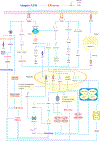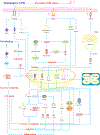Endoplasmic reticulum stress in liver diseases
- PMID: 35524448
- PMCID: PMC9637239
- DOI: 10.1002/hep.32562
Endoplasmic reticulum stress in liver diseases
Abstract
The endoplasmic reticulum (ER) is an intracellular organelle that fosters the correct folding of linear polypeptides and proteins, a process tightly governed by the ER-resident enzymes and chaperones. Failure to shape the proper 3-dimensional architecture of proteins culminates in the accumulation of misfolded or unfolded proteins within the ER, disturbs ER homeostasis, and leads to canonically defined ER stress. Recent studies have elucidated that cellular perturbations, such as lipotoxicity, can also lead to ER stress. In response to ER stress, the unfolded protein response (UPR) is activated to reestablish ER homeostasis ("adaptive UPR"), or, conversely, to provoke cell death when ER stress is overwhelmed and sustained ("maladaptive UPR"). It is well documented that ER stress contributes to the onset and progression of multiple hepatic pathologies including NAFLD, alcohol-associated liver disease, viral hepatitis, liver ischemia, drug toxicity, and liver cancers. Here, we review key studies dealing with the emerging role of ER stress and the UPR in the pathophysiology of liver diseases from cellular, murine, and human models. Specifically, we will summarize current available knowledge on pharmacological and non-pharmacological interventions that may be used to target maladaptive UPR for the treatment of nonmalignant liver diseases.
Copyright © 2023 American Association for the Study of Liver Diseases.
Conflict of interest statement
CONFLICT OF INTEREST
GK holds research contracts with Daiichi Sankyo, Eleor, Kaleido, Lytix Pharma, PharmaMar, Samsara, Sanofi, Sotio, Vascage and Vasculox/Tioma. GK is on the Board of Directors of the Bristol Myers Squibb Foundation France. GK is a scientific co-founder of everImmune, Samsara Therapeutics and Therafast Bio. GK is the inventor of patents covering therapeutic targeting of aging, cancer, cystic fibrosis and metabolic disorders.
Figures




Similar articles
-
The Dynamic Role of Endoplasmic Reticulum Stress in Chronic Liver Disease.Am J Pathol. 2023 Oct;193(10):1389-1399. doi: 10.1016/j.ajpath.2023.03.009. Epub 2023 Apr 6. Am J Pathol. 2023. PMID: 37028592 Free PMC article. Review.
-
Regulation mechanism of endoplasmic reticulum stress on metabolic enzymes in liver diseases.Pharmacol Res. 2024 Sep;207:107332. doi: 10.1016/j.phrs.2024.107332. Epub 2024 Jul 30. Pharmacol Res. 2024. PMID: 39089398 Review.
-
The unfolded protein response and hepatic lipid metabolism in non alcoholic fatty liver disease.Pharmacol Ther. 2019 Nov;203:107401. doi: 10.1016/j.pharmthera.2019.107401. Epub 2019 Aug 13. Pharmacol Ther. 2019. PMID: 31419516 Free PMC article. Review.
-
ER stress and inflammation crosstalk in obesity.Med Res Rev. 2023 Jan;43(1):5-30. doi: 10.1002/med.21921. Epub 2022 Aug 17. Med Res Rev. 2023. PMID: 35975736 Review.
-
The adaptive endoplasmic reticulum stress response to lipotoxicity in progressive human nonalcoholic fatty liver disease.Toxicol Sci. 2014 Jan;137(1):26-35. doi: 10.1093/toxsci/kft230. Epub 2013 Oct 4. Toxicol Sci. 2014. PMID: 24097666 Free PMC article.
Cited by
-
Aging, oxidative stress and degenerative diseases: mechanisms, complications and emerging therapeutic strategies.Biogerontology. 2023 Oct;24(5):609-662. doi: 10.1007/s10522-023-10050-1. Epub 2023 Jul 30. Biogerontology. 2023. PMID: 37516673 Review.
-
The role of ubiquitination and deubiquitination in the pathogenesis of non-alcoholic fatty liver disease.Front Immunol. 2025 Apr 11;16:1535362. doi: 10.3389/fimmu.2025.1535362. eCollection 2025. Front Immunol. 2025. PMID: 40292292 Free PMC article. Review.
-
Induction of MASH-like pathogenesis in the Nwd1-/- mouse liver.Commun Biol. 2025 Mar 11;8(1):348. doi: 10.1038/s42003-025-07717-5. Commun Biol. 2025. PMID: 40069352 Free PMC article.
-
Targeting Metabolism: Innovative Therapies for MASLD Unveiled.Int J Mol Sci. 2025 Apr 25;26(9):4077. doi: 10.3390/ijms26094077. Int J Mol Sci. 2025. PMID: 40362316 Free PMC article. Review.
-
Morin: a promising hepatoprotective agent against drug and chemical-induced liver injury.Naunyn Schmiedebergs Arch Pharmacol. 2025 Jun 26. doi: 10.1007/s00210-025-04394-3. Online ahead of print. Naunyn Schmiedebergs Arch Pharmacol. 2025. PMID: 40569367 Review.
References
-
- Wang M, Kaufman RJ. Protein misfolding in the endoplasmic reticulum as a conduit to human disease. Nature 2016;529:326–335. - PubMed
-
- Ajoolabady A, Wang S, Kroemer G, Klionsky DJ, Uversky VN, Sowers JR, Aslkhodapasandhokmabad H, et al. ER stress in cardiometabolic diseases: from molecular mechanisms to therapeutics. Endocrine Reviews 2021. - PubMed
-
- Ren J, Bi Y, Sowers JR, Hetz C, Zhang Y. Endoplasmic reticulum stress and unfolded protein response in cardiovascular diseases. Nature Reviews Cardiology 2021;18:499–521. - PubMed
Publication types
MeSH terms
Substances
Grants and funding
LinkOut - more resources
Full Text Sources
Medical

